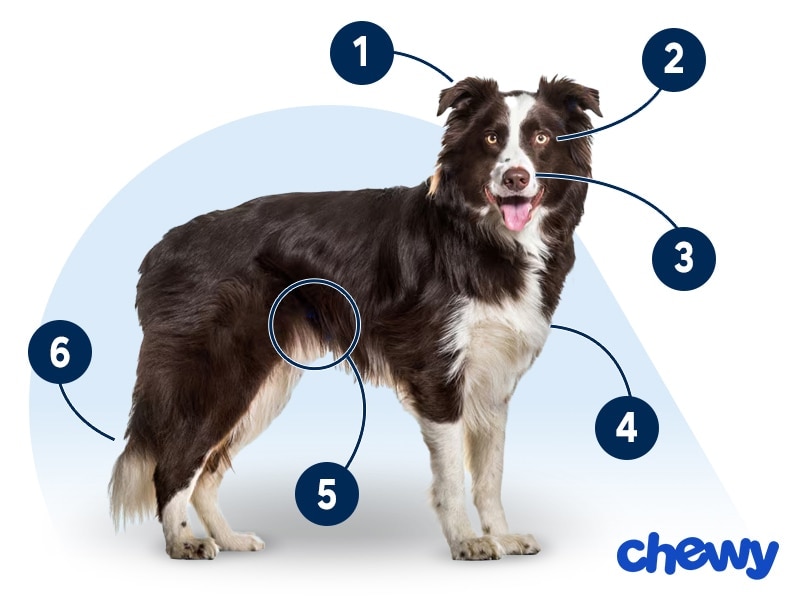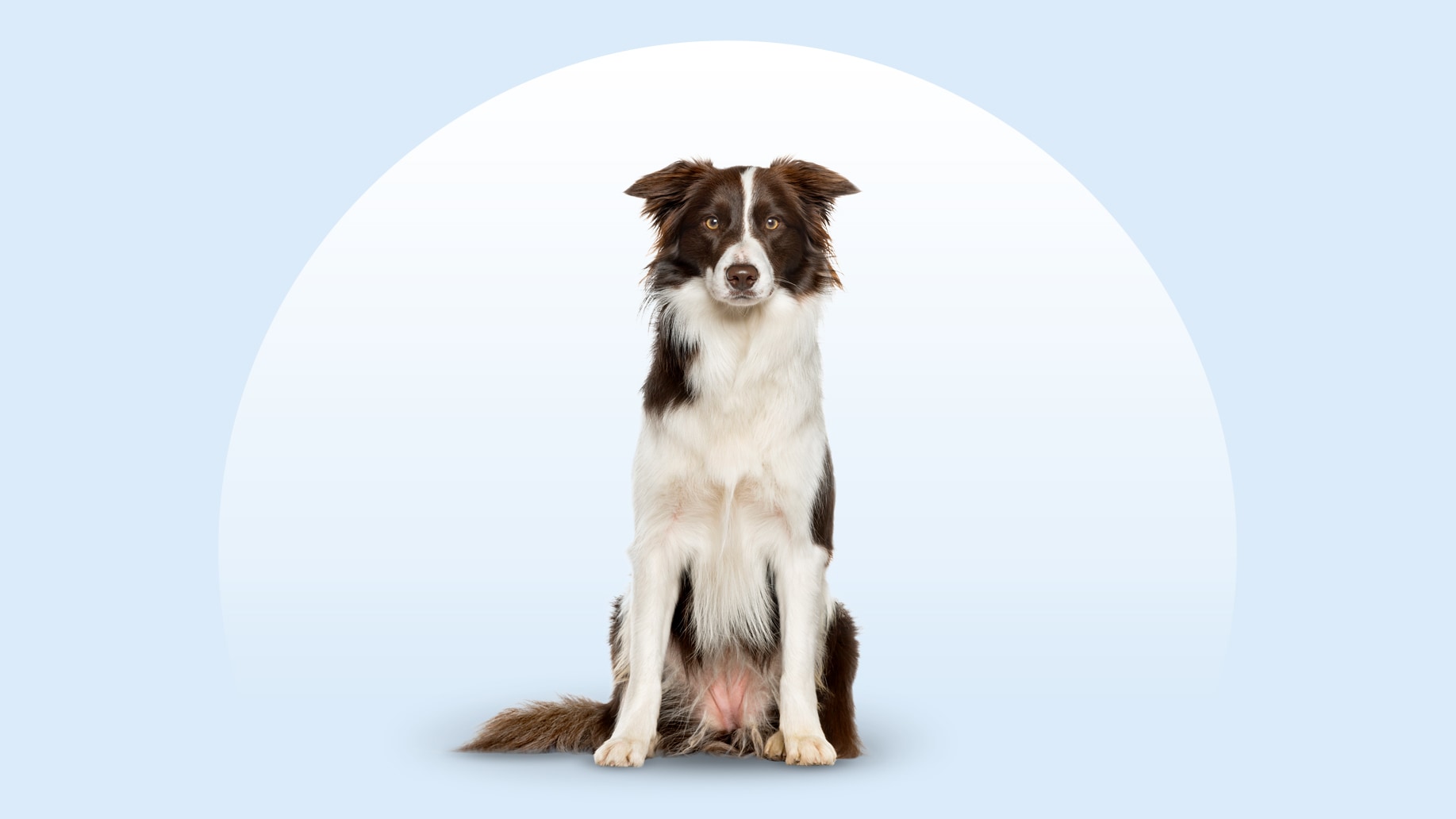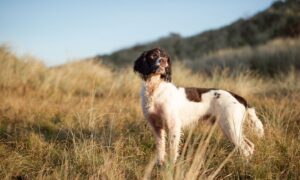Border Collie
Updated June 4, 2025
Border Collie
Updated June 4, 2025
Smart and bursting with energy, Border Collies do best with experienced dog parents who have plenty of time to train their pup. These dogs usually prefer to be the only “child,” and their dream home has lots of room to run.
Active, Confident, Genius
30–55 pounds
18–22 inches
12–15 years
Black, Blue, Blue Merle, Red, Red Merle, Sable, White and Black, White and Blue Merle, White and Red, Lilac, Saddleback Sable, Sable Merle, Gold, Brindle, White and Blue, White and Red Merle, White Ticked
The Border Collie is the class valedictorian of canines. These bright overachievers are not only one of the smartest—OK, maybe the smartest—dog breeds out there, but they’re also star athletes.
If these dogs were in high school, they’d be rife with extracurriculars. Border Collie dogs excel at running, search and rescue, and anything else that lets them be active and around others. A true go-getter, Border Collies are good at lots of things, and being your best friend is one of them.
Border Collie Characteristics
Border Collie Appearance
Athletic and active Border Collies exude strength, and their oval eyes give off an intensive, expressive gaze. Their adorably twitchy ears are always alert as they take in the world around them, and their tail stands proudly when they’re happy or excited.
They have double-coated fur, and it’s possible to have one of two types: a rougher medium-length coat or a smoother short-haired coat. Border Collie colors run the gamut.

- Ears
Border Collie ears are medium in size, pointed, and often in an alert position.
- Eyes
Their eyes are moderately sized ovals. They're usually brown but can also be blue.
- Nose
The Border Collie’s muzzle is slightly tapered, leading to a pointed, medium-sized nose.
- Coat Length
They have double-coated fur, and it’s possible to have one of two types: a rougher medium-length coat or a smoother short-haired coat.
- Coat Color
The Border Collie’s coat comes in a wide range of colors and patterns, including black, blue, red, blue or red merle, sable, white and black, gold, brindle, and more, including lilac (which looks like a soft brown).
- Tail
Their tail hangs low, is long, and may curve at the end.
Border Collie Temperament
Like an overachieving human with a to-do list, the Border Collie finds joy in routine, purpose, and fulfilling tasks. Without an assigned job, they may create their own list (think chewing socks or digging holes), so make sure to keep them focused on healthy diversions.
With a trail of toys in their wake and a love of their person, Border Collies are the quintessential dog. Back in the day, they were bred for herding sheep, and it’s a role that they still take seriously (even when the sheep are nowhere to be found). They might try to herd other pets or even people, so it’s ideal to socialize your Border Collie early on to get them used to roommates, whether two- or four-legged.
They appreciate routine and may get overwhelmed if the house is too chaotic, so keep things as orderly as possible with these pups and follow a schedule where they can predict their next walk or playdate.
Border Collies are a great family dog. Affectionate and happy to be part of your pack, they just need guidance on their role. They’ll see you as an equal and want you to tell them everything you’re doing and why. They’ll also shower you with affection so you’ll never feel alone—even when you’d like to be, for better or worse.
Loyal and caring, the Border Collie is also pretty sure that they know best, so don’t be surprised when they appoint themselves Park Ranger at the dog run. Train them when they’re young so they learn to relax a bit and understand that not everything is a herding opportunity.
How to Care for a Border Collie
A Border Collie may be highly intelligent, but that doesn’t mean they don’t need guidance. Plenty of exercise, human interaction, mental stimulation, and a steady routine that includes grooming, training, and outdoor “tasks” will set these people-pleasing pups up for success.
Grooming
Training
Diet
Exercise
Environment
Border Collie Health
A Border Collie lifespan is 12–15 years. They’re prone to some health issues, so keep an eye out and let your vet know of any problems.
- Collapsing after exercise: Border Collie collapse (BCC) happens when an otherwise healthy Border Collie becomes dazed or disoriented during or after intense exercise. A Border Collie may seem uncoordinated or confused for five to 20 minutes or so. It’s unclear why this happens, although genetics may be a factor.
- Deafness: Congenital deafness has been noted in Border Collies. While the specific genetic defects have not been identified, the risk may be higher in merle color patterns, Border Collies with mostly white heads, and those with two blue eyes.
- Epilepsy: Seizures in dogs with epilepsy usually begin between the ages of 6 months and 5 years, and they may range from mild to severe. Treatment is usually daily meds.
- Eye issues: Border collies are prone to two potential genetic eye conditions: collie eye anomaly (CEA) and progressive retinal atrophy (PRA). There are genetic screening tests for both conditions, but neither has a cure. But blind dogs or those with limited vision can do very well and have good quality lives.
- Hip dysplasia: Hip dysplasia occurs when the ball and socket of the hip and thigh bones doesn’t properly fit; it can be an inherited condition. It often results in pain, limping, and arthritis. Treatment options include weight management, physical therapy, joint supplements, pain medication, and, in severe cases, surgery.
- Multidrug resistance mutation (MDR1): MDR1 is a genetic condition that makes dogs more prone to serious side effects of certain medications. A genetic screening test exists, and you should discuss the right choice for medication with your vet.
- Neuronal ceroid lipofuscinosis (CL): CL is a genetic disorder that causes neurologic symptoms such as tremors, seizures, blindness, and shortened lifespan. Genetic screening testing is available, and breeding dogs should be tested.
- Trapped neutrophil syndrome (TNS): TNS is a genetic condition that compromises a Border Collie’s immune system and can lead to severe infections. This condition is not curable and is, unfortunately, fatal.
Border Collie History
Amidst picturesque landscapes on the border between England and Scotland, a remarkable breed of sheepdog emerged: the Border Collie. Rooted in Scottish heritage, the word “Collie” was used to describe working dogs, such as herders. In the mid-19th century, Queen Victoria raised several of these energetic dogs, which helped distinguish the Border Collie breed as we know it today from the Collie dog of older times.
Their heritage as a sheep dog is never far beneath the surface: You know a Border Collie by their live-to-work mentality and for “the stare”—the piercing gaze they give sheep (or whatever modern-day thing they feel like herding) to get in line. In 1995, the American Kennel Club (AKC) recognized the Border Collie as its own breed.
Today, Border Collies hold a special place in the zeitgeist: They star in dog sports such as sheepdog trials (as exemplified in the movie “Babe”) and hold many Guinness World Records, both serious and silly (a notable one is “the fastest time a dog has unwound a nonelectric car window”). Chaser, known as the World’s Smartest Dog, was a Border Collie who understood more than 1,000 words.
Thinking of bringing a Border Collie puppy or adult dog home? Reach out to Border Collie rescue organizations, keep an eye out at your local animal shelter for Border Collie rescue dogs, or search Chewy’s database of adoptable dogs in your area.








